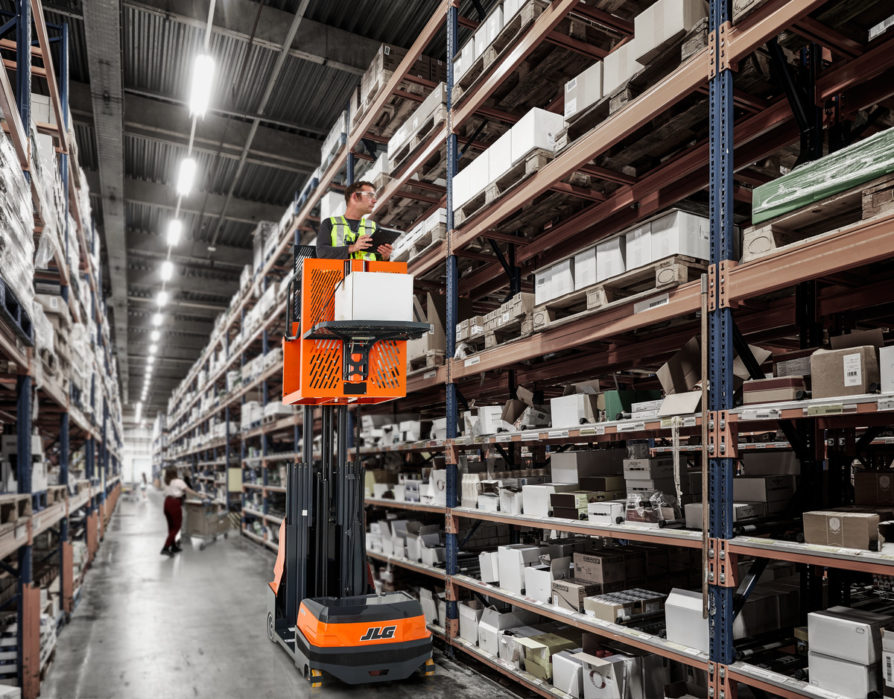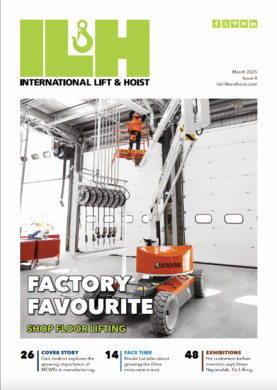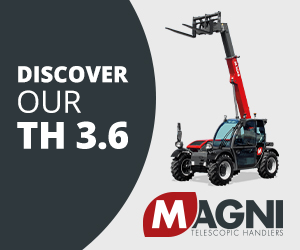)
Land of Promise
MEWPs have been an integral part of the Middle East construction boom for decades. But beyond the building site, how else are MEWPs being deployed in this region? Dan Jenkins finds out.
Mobile elevating work platforms (MEWPs) have helped shape new cityscapes across the Middle East, especially in Saudi Arabia and the United Arab Emirates (UAE).
While construction remains the main application for MEWPs in this region, other sectors have noted their productivity and safety benefits.
Joel Quadras is country manager for the UAE for Manlift Middle East. Part of the Riwal Group, Manlift Middle East LLC is the region’s largest MEWP and lifting equipment specialist.
“In the UAE we are diversifying, he says. “Here, 62% of our revenue is dependent on construction, whereas 38% of revenue is non-construction. This is mainly from facilities management, which is increasingly mature, followed by industrial, such as solar. They are developing a lot of solar production as they want to have a fully sustainable city by 2030 supported by infrastructure like the Mohammed Bin Rashid Al Maktoum Solar Park – so that is huge in the UAE.
“This is followed by events, plus we are also targeting the film-making sector here and already hiring machines into it. So, you can see that Manlift has a diverse portfolio outside of construction in the UAE.”
Sector development
Economic growth and growing diversity within regional economies is driving growth – and OEMs believe that there remains plenty of headroom to increase sales.
Ian Hume, sales director Middle East, India and Africa for JLG says, “The Middle East markets still have a lot of growth to come on use of MEWPs. This is particularly evident within the facilities maintenance, manufacturing, and logistics space. Scaffolding is still being used extensively within these sectors. At JLG we are continually trying to bring new products to the market that offer a safer and more efficient solution such as our Toucan, Power Tower and Stock Picking range.”
Unsurprisingly, the primary sector for MEWPs after construction is the oil and gas industry. “We are also predicting the oil and gas landscape to see considerable investment across the region,” adds Hume. “By the end of 2024 we will see some of these oil and gas projects make huge progress and the mega projects of Saudi Arabia will be taking shape. Between now and then I am confident we will see rental demand of MEWPs outstrip the number of machines currently in the market.”
Malcolm Early, Skyjack’s Vice-President Marketing concurs. “Major infrastructure development and oil and gas production continues to drive demand in the region,” he adds. “This is currently being led by Saudi Arabia who have recently announced a number of significant new city development projects. While booms, particularly larger models, continue to lead the way, there is increasing demand for electric scissors which are being used for general upkeep and maintenance on projects which were built some years ago, such as shopping malls.”
Buoyant region
The UAE led the adoption of MEWPs in the region, but other states are rapidly catching up. Robert Cavaleri, manlift’s regional training, safety and compliance manager, says, “UAE is more mature as people are very aware of the benefits MEWPs bring to working safely and productivity at height. MEWPs are now one of the first choices for working at height in UAE.
“It is not just in construction but across sectors like industrial and facilities management as well. Even in sectors such as oil and gas and aviation. Joel’s team has ambitious targets in 30 sectors, so we are working hard to raise awareness and demonstrate viable alternatives to working at height.
“This is being supported by organisations such as Occupational Safety and Health in Abu Dhabi (OSHAD) are referencing IPAF as best practice in terms of training and competency. IPAF is reaching out to a lot of organisations in UAE. We are an accredited IPAF training centre and are working closely with them, among other organisations, to help bring more awareness about the benefits of MEWPs.”
The same is true for JLG. “UAE remains the most mature market within the Middle East with MEWPs being used across a wide industry spectrum,” says Hume. “The UAE has been supported by a large number of international companies within the tourism, manufacturing, oil and gas and construction sectors that have brought safety and efficiency best practices to the UAE. The UAE has also been supported by the MEWP manufacturers and IPAF to continue pushing safety standards higher.
“Qatar and Saudi Arabia are developing fast on the UAE’s heels, and we expect to see these two countries make great progress over the next five years.”
Fittingly, Genie is also very active in this region. Sharbel Kordahi, Genie Managing Director, Middle East adds, “We’re seeing the highest demand in Saudi Arabia, the UAE, Qatar, Kuwait and Bahrain. This demand is driven mainly by new projects in the oil and gas sector. Most of the market is still developing. The exception is the UAE, where the market is now almost 20 years old and there is a good amount of equipment.”
Manlift’s Cavaleri believes that bureaucratic changes in the Kingdom of Saudi Arabia (KSA) are making a difference. “There has been significant investment in the ease of doing business in KSA. It is easier to get visas and easier to trade in KSA. Some of the legacy red tape issues have gone.” His colleague Quadras adds, “KSA undoubtedly is a very vibrant market right now. Strategically they are filling in any gaps in industry, such as logistics and hospitality sectors. A lot of resources are going into those developments.”
Based in Dubai, Manlift has been operating in the region since 2007 and marks its 15th anniversary this year. “We have ridden the wave from the early days,” says Cavaleri. “IPAF has been here nearly as long as we have, and we work arm in arm together. I have been Chair of the IPAF Council and Manlift has been on the council since its inception.
“We worked closely with IPAF for years, whether that was site visits or holding open days, to help raise awareness. That work paid off and we’ve seen the market grow pretty rapidly. We took market share pretty quickly from scaffolding and from mobile towers. Our main challenge wasn’t generating demand but ensuring we had sufficient supply of machines to meet it.”
“Making sure that there is also awareness about competency and having the correct training is also vital. Being an accredited IPAF training centre is a big part of our brand and has helped in our development.”
Sales model
As with many developing markets, most of the OEMs operate a hybrid sales model. Volume sales to major contractors and rental companies are handled directly, while a network of dealers looks after smaller clientele.
“For retail sales we are very fortunate to have an extensive distributor network across the Middle East,” says JLG’s Hume. “We pride ourselves on our long relationships with most of our distributors being our partners for over a decade with some stretching back over 30 years.
“JLG supports their key international and global rental accounts directly within the region. JLG has the largest direct team as we deliver technical and sales support wherever it is needed.”
Genie operates in the same way. “We have a hybrid model with a focus on dealers, which means that we sell mainly through dealers, but we also have a number of key accounts, mainly with big rental companies, who buy from us directly,” adds Kordahi.
Popular products
For Quadras, part of Manlift’s success is based on bringing new technology to the market. “The engagement we kept with the customers on evolving technology was key,” he says. “We were not just focused on renting the machines we had. As MEWPs have evolved and the technology evolved, we have brought those new solutions and modifications to the market. In that way we really increased the market share with MEWPs compared to traditional methods of working at height.”
An example of this approach to innovation is My Manlift, a pioneering app and customer portal which is marketed outside of the MENA region as My Riwal. My Manlift provides a summary of all machines on rent, invoicing, machine locations, and even the ability to off rent or re-order a machine.
“My Manlift is a big evolution for our customers as everything can now be done through a mobile app,” he continues. “Customers trust us to take them through their journey from selecting the right machine to paying the invoice. It really positions us as ahead of the rest of the market.”
JLG has taken a similar approach. “Over the last year we have launched three new products to the MEA market,” says Hume. “In 2022 we brought the worlds first All Electric Scissor Lift in the form of the Davinci. This machine is unique as it has zero hydraulics and therefore no chance for any leaks.
“We have delivered the first Electric Construction (EC) Booms to our region. These 16m and 18m working height booms are lithium powered booms that give the user the same performance as a diesel equivalent. This is the future here in the Middle East as we all work towards a more sustainable and environmentally friendly future.”
JLG also recently launched its Driveable Stock Picker (DSP) range in the Middle East. “By the end of 2022 we will have added the largest in the range the DSP-L which has a working height of 7.8m that has been built to support the warehousing market.
“JLG offers our customers the widest range of access products globally. From a volume standpoint the JLG Boom range is still the industry benchmark and proves to be our most popular range. We are seeing encouraging year on year growth within our vertical range as we see the market mature. Products like our Toucan 12E which boasts 12.65m working height and over 6m outreach are becoming more commonly found with our rental and retail partners. The Toucan range is an electric mast boom lift with a very small footprint that is perfect for facility maintenance.”
Booms are Genie’s most popular MEWPs in the market, with a preference for straight booms 65 ft (19.81 m) and above, all the way to the 186 ft (56.86 m) working height of the Genie® SX™-180, which is Genie’s highest-reaching boom. “These booms provide the rigidness and robustness needed for the most common jobsites in this region, namely oil and gas and construction,” says Kordahi.
“We recently introduced the S-80 J and S-60 J telescopic booms. In May, Genie provided the opportunity for eight Middle East access hire companies to see the S-80 J firsthand, ask questions and provide feedback about the boom during a demo tour in the UAE.
“In general, these customers cited the machine’s single-envelope, optimized design as a key benefit of the Genie J series booms. The machine’s design reduces overall inspection points and wearable components, which speeds up inspections and reduces the time and expense of maintenance and repairs. This results in a lower total cost of ownership and helps improve rental return on invested capital (rROIC).”
All of Skyjack’s rough terrain booms utilize an axle-based drive system which the company says optimizes performance while also minimizing the cost of maintenance throughout the lifecycle of the machine. As with Skyjack’s scissor lifts, a focus of the boom design was to allow for ease in troubleshooting and repairs.
“One of the most significant changes to the boom line was to increase the platform capacities on all the 40’ and 60’ models,” says Early. “This allows for more personnel, more tools, and more materials on the platform, making the machines more versatile and work more efficiently.
“Another unique feature, Easydrive, is common across all Skyjack booms. Machine controls always operate with respect to the orientation of the boom – regardless of the position of the turret over the chassis. This feature reduces operator confusion by eliminating the need for color coded arrows on the chassis to determine drive versus joystick direction.”
Electrification
Many onlookers might not think that such a fossil fuel-rich region was interested in the growing trend of replacing diesel and petrol MEWPs with lithium battery models. However, OEMs and rental companies are making inroads.
“The trend to electrification of MEWPs is already there in the UAE in particular,” says Manlift’s Quadras. The mindset of both government and business is aligned in terms of progressing steadily towards sustainability.
“At Manlift we are targeting a sustainable supply chain and are investing heavily in this area. We are transitioning our fleet from diesel to electric. “We are already at 30% of our fleet being electric and hybrid in UAE and our sustainability target is to reach 32% by the end of this year. We recently brought in hybrid machines on customer trials, which were very successful. So, we will look to deploy more hybrids as well.”
Cavaleri adds, “It is still more push than pull. A rental company like Manlift will have electric and hybrid machines and will offer them to the customer. If a client wants a 60ft boom and an electric version can offer the same performance, the customer will go for it. The challenge for rental companies is more around acquiring those machines at the same price as the diesel equivalents.
“Our commercial teams are tasked with raising awareness because we are a sustainable organisation. So, we help our customers make more informed choices by explaining the benefits of hybrid and electric machines. We are also looking at biodiesel, putting some of those machines through their paces for a cost comparison, as that could provide an interim measure.”
Genie is seeing a similar trend. “Looking ahead, we expect electrification to be an important trend because, like other places around the globe, there is a big push toward improving sustainability, reducing emissions and lowering the carbon footprint of jobsites,” says Kordahi. “As a result, Genie customers in the Middle East can expect us to bring additional models into the region that will meet this demand for robust, quality, zero-emissions equipment.”
Forecasting the future
The future looks bright for the region but is not without its challenges. Like rental companies everywhere, Manlift faces the challenge of rising costs for purchasing MEWPs. Quadras says, “The cost to manufacture a MEWP has increased, due to supply chain issues. Those higher costs are not yet being reflected in higher rental rates. If that continues, it will hinder growth.”
Cavaleri adds, “Moving forward there will be more pressure from governments on businesses to adopt sustainable methods of working at height. So, the focus will not just be on the safest way to work at height.
“The speed at which you can get a job done with a MEWP will also be a factor in market growth. There is growing pressure on contractors to complete projects to tighter timeframes. That will focus them far more on planning and on finding timesaving or efficiency gains such as using more MEWPs. Similarly with FM, they have productivity targets and MEWPs will help meet them.”
While economies are diversifying, they remain heavily reliant on oil and gas. “If oil and gas prices continue at or near where they are today, there is likely to be expansion, and this will be a very strong market,” says Genie’s Kordahi. “That said, we always have to consider that we are in a very volatile region when it comes to geopolitical stability, which could have an impact. But, as it is looking today, there is a lot of potential and the market looks like it will continue to improve in the next couple of years.”
JLG is very optimistic that growth will remain strong. “We are now coming out of the pandemic and with the regional vision I am very optimistic we will see the market continue to grow above the global average,” says Hume.
“Saudi Arabia alone has a very strong project pipeline that will demand growth of MEWPS. The key difference to this demand verses similar demand 15 years ago in the UAE is that MEWPS are now an integral equipment within the build.”











